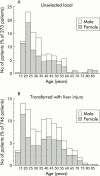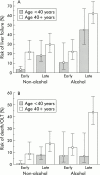Age and paracetamol self-poisoning
- PMID: 15831917
- PMCID: PMC1774490
- DOI: 10.1136/gut.2004.054619
Age and paracetamol self-poisoning
Abstract
Background: Whereas paracetamol poisoning is predominantly seen in adolescents and young adults, the majority of paracetamol associated deaths occur in an older population.
Aims: The aim of the present study was to evaluate age as a risk factor for fulminant hepatic failure (FHF) and death in a large population of patients with paracetamol poisoning.
Patients: A total of 746 patients transferred to a specialised unit with severe paracetamol poisoning and 273 unselected patients admitted from the local region over a 10 year period.
Methods: A partly retrospective study based on hospital charts. The risk associated with age was evaluated by multivariate analysis.
Results: Paracetamol poisoning most frequently occurred in the age group 15-24 years. Transferred patients were significantly older than local patients (median age 37 years v 29 years; p = 0.0006). In contrast, FHF and death from paracetamol poisoning most frequently occurred in patients aged 40 years or above. In a logistic regression analysis, "age >/=40 years" was associated with an excess risk of FHF (odds ratio (OR) 2.33 (95% confidence interval (CI) 1.50-3.64)) and death or liver transplantation (OR 4.18 (95% CI 2.17-8.05)). In addition, older age was associated with other risk factors for paracetamol hepatotoxicity such as regular alcohol abuse and late presentation.
Conclusions: Age 40 years or above was identified as a significant independent risk factor for FHF and mortality following paracetamol overdose. Patients aged 40 years or above should be considered as high risk patients, in particular when older age appears in combination with regular alcohol abuse or late presentation.
Figures






References
-
- Larsen FS, Kirkegaard P, Rasmussen A, et al. The Danish liver transplantation program and patients with serious acetaminophen intoxication. Transplant Proc 1995;27:3519–20. - PubMed
-
- Makin AJ, Wendon J, Williams R. A 7-year experience of severe acetaminophen-induced hepatotoxicity. Gastroenterology 1995;109:1907–16. - PubMed
-
- Ostapowicz G, Fontana RJ, Schiødt FV, et al. Results of a prospective study of acute liver failure at 17 tertiary care centers in the United States. Ann Intern Med 2002;137:947–54. - PubMed
-
- Peterson RG, Rumack BMH. Age as a variable in acetaminophen overdose. Arch Intern Med 1981;141:390–3. - PubMed
-
- Wynne H, Bateman DN, Hassanyeh F, et al. Age and self-poisoning: the epidemiology in Newcastle upon Tyne in the 1980s. Hum Toxicol 1987;6:511–15. - PubMed
MeSH terms
Substances
LinkOut - more resources
Full Text Sources
Medical
